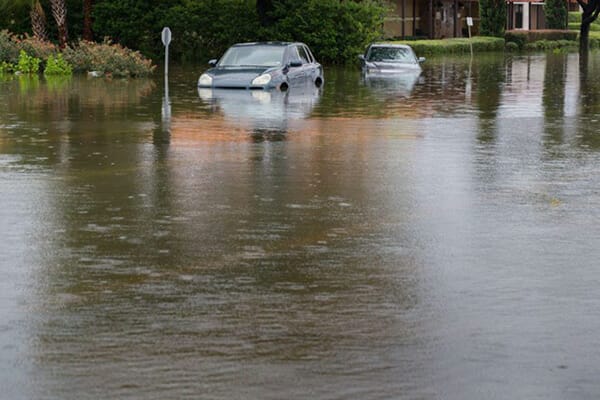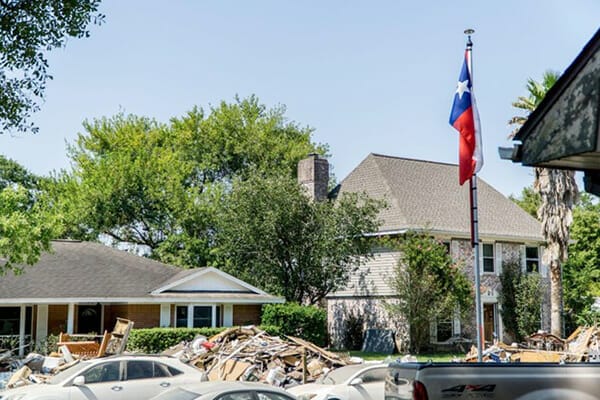Many areas in the U.S. feel the full force of hurricane season, leaving some people on high alert during specific times of the year. The states most impacted by hurricanes border the Atlantic Ocean and run up the eastern seaboard. The most impacted states include Florida, Texas, Louisiana, North and South Carolina, Alabama, Georgia, Mississippi, New York, and Virginia.
While these states are among the most affected, the risk isn’t the same year-round. These states all have hurricane seasons that vary by region. Atlantic hurricane season is June 1 through November 30; Eastern Pacific hurricane season is May 15 through November 30, and the main hurricane season for both U.S. coasts is August through October.
In Texas, hurricane season falls into the Atlantic hurricane season (June 1 through November 30). To help you weather the storm safely, we’re sharing some insights and facts on hurricanes versus tropical storms, what Texas hurricane season is actually like, and what you should do to properly prepare for more than just heavy rain.
What’s the Difference Between a Hurricane and a Tropical Cyclone?
According to the National Oceanic and Atmospheric Administration (NOAA), a tropical cyclone is a generic term meteorologists use to define a rotating, organized cloud and thunderstorm system that begins in tropical or subtropical waters with closed, low-level circulation.
Within this broad title are hurricanes, typhoons, and tropical cyclones — yes, there’s also a more defined tropical cyclone under the larger tropical cyclone umbrella.
To begin, let’s define what makes a tropical cyclone — the umbrella term — escalate to a hurricane or typhoon. All tropical cyclones with sustained wind speeds under 39 miles per hour (mph) are tropical depressions. They become more destructive storms — aka hurricanes or typhoons — when they reach sustained winds (not just short gusts) of at least 74 mph. Given tropical cyclones share the name of the broader umbrella term, they occur anytime there is cyclonic action, regardless of wind speeds.
Now, digging deeper into the difference between a hurricane, typhoon, and tropical cyclone, it all depends on where they originate. If the storm originates in the North Atlantic, Central North Pacific, and Eastern North Pacific, it’s a hurricane. If it begins in the Northwest Pacific, it’s a typhoon. If the storm starts in the South Pacific and the Indian Ocean, it’s considered a tropical cyclone, regardless of wind speeds.
What’s Texas Hurricane Season Like?
Now that we know when Texas hurricane season is, you’re likely wondering what it’s like living during Texas hurricane season.
In most years, upward of 100 storms and tropical disturbances arrive in the Atlantic Ocean, potentially threatening Texas. On average, two of these disturbances become hurricanes and reach land in the U.S. Since 1851, some 66 hurricanes have impacted Texas, including direct landfall and indirect impacts.
According to NOAA, Texans can anticipate a hurricane landfall once every 13 years and a major hurricane (Category 3 or stronger) once every 31 years. Remember that climate change is warming ocean temperatures and causing more extreme weather events, which can impact this over time.
Texas hurricanes have varied greatly in category, including:
- 27 Category 1 hurricanes
- 13 Category 2 hurricanes
- 16 Category 3 hurricanes
- 10 Category 4 hurricanes
To date, Texas has never felt the impact of a Category 5 hurricane, which is the strongest.
What Are Some Historic Texas Hurricanes?
Though Texas has never experienced the full brunt of a Category 5 hurricane, it’s had plenty of memorable ones. For example, the costliest hurricane was Harvey — a Category 4 hurricane — in 2017, which battered the Corpus Christi area and along the Gulf of Mexico coastline in Texas and Louisiana, leaving behind $148.8 billion worth of damage.
While Hurricane Harvey was the most destructive, it wasn’t the deadliest Texas hurricane. That title belongs to the Great Galveston Hurricane of 1900, which killed at least 8,000 people. Part of the Galveston hurricane’s deadly nature was its record 15-foot storm surge that engulfed the Galveston, Texas area.
Wind speeds at landfall play a big role in a hurricane’s destructiveness. Hurricanes that hit land in Texas with the strongest winds include Laura in 2020, Indianola in 1886, and Freeport in 1932, which all hit land with an estimated 150 mph wind speeds.
The strongest-ever recorded hurricane winds from Texas hurricane belong to 1980’s Hurricane Allen, which crossed the Yucatan Channel with wind speeds reaching Category 5 levels of 190 mph.
Enter your ZIP Code and compare electricity rates
How Can You Stay Safe During a Texas Hurricane?
Staying safe during a Texas hurricane all starts with preparation and ends with knowing who to contact if you run into an emergency or need assistance. But what should you prepare when a hurricane threatens the Texas coast? Here are some basic supplies to get you started:
- Drinkable water
- Non-perishable food
- First-aid kit
- Blankets and sleeping bags
- Sanitary items
- Money
- Utensils
- Flashlights
- Batteries
- Extra clothes
Some other tips to consider to help you remain safe during a Texas hurricane include:
- Stay inside: A mandatory evacuation may force you from your home, but this doesn’t mean you have to encounter a hurricane without shelter. Ensure your safety by staying at home or a local hurricane shelter. This will help protect you from flying debris and keep you from other dangers associated with the high winds from a Texas hurricane.
- Avoid all glass: Windows and glass can shatter from high winds and flying debris during a hurricane. Your safest best is to shelter yourself far from windows and glass, such as near the center of your home in a windowless room. This can be a large closet, bathroom, or other room without a window.
- Fill up your bathtub: Water can become scarce during severe hurricanes, so you must store as much water as possible. Your bathtub can be a massive space to hold potable water if the water shortage continues longer than expected, which can be a lifesaver.
- Have a battery-operated or hand-crank radio: During a severe Texas hurricane, the only information you may find could be on the radio. This is where a battery-operated or a hand-crank radio can be instrumental to your survival. If the local government is searching for survivors in a severe storm, a radio broadcast may be your only way to know how to find help.
How Do You Prepare for a Power Outage?
Extended power outages are also common during severe Gulf Coast hurricanes, sometimes spanning days or weeks. As such, you’ll want to prepare for power outages ahead of time. Here are some tips for preparing for power outages during a Texas hurricane:
- Make sure you have alternative power sources: Alternative power supplies, such as a collection of batteries in various sizes and power banks, can go a long way in running smaller electronics like a radio, cell phone, and more.
- Get backup medical equipment: If you require medical equipment that runs on electricity, such as a hearing aid or respirator, speak to your medical provider about backup systems to ensure they continue operating during a power outage.
- Purchase a generator: A home generator can be a great way to keep your basics — like your refrigerator, stove, radio, and toaster oven — powered with gasoline or diesel. Remember, to operate generators safely by only running them outside, keeping fuel at least 20 feet away from them, installing in-home carbon monoxide detectors, and using heavy-duty extension cords.
- Monitor power outages: Monitoring power outages can be a helpful way to know how long your power may be out and how long you need to ration food, fuel, and water.
- Toss out food: If you don’t have a generator or it runs out of fuel, the countdown for food safety starts as soon as the power goes out. If your refrigerated food has been in 40-degree or higher temperatures for two hours or longer, toss it out to avoid food-borne illnesses. The same goes for refrigerated medications left without power for two or more days.
How Do You Stay Safe During Flooding?
Flooding is also a big risk during a hurricane. The National Weather Service offers flooding tips to help you remain safe:
- Avoid standing water: Standing water could carry an electrical current from downed power lines. Avoid these areas to prevent potential electrocution or shock.
- Get information: Listen to local news broadcasts for updates via a battery-powered radio if cell phone lines are down.
- Avoid flowing streams: It may seem tempting to cross what appears to be a shallow flowing stream to get to safety. However, these streams may be deeper and the currents stronger than you expect, which can sweep you away in the current.
- Don’t drive through floods: Flooded roadways may stand between you and safety, but these flooded roads can be deceptively deep and have fast currents. This can result in your vehicle stalling and being swept away by the current, so never attempt to cross these areas.
What Are the Best Resources to Contact in a Texas Hurricane?
In addition to all the tips we mentioned for staying safe during a Texas hurricane, you’ll want to keep necessary phone numbers and emergency management services in case you need them. Just as there is Texas aid for winter storms, there are resources to help you year-round. These include:
- Red Cross shelters
- Drive Texas for updates on road conditions
- Texas Hurricane Center to register for special assistance, if needed
- Important phone numbers:
- 2-1-1 for shelter, food, and disaster services
- 7-1-1 for Relay Texas Service
- 1-800-452-9292 for TxDOT statewide road closures and evacuation routes
- 1-800-525-5555 for roadside assistance
Texas Hurricane Preparedness Helps You Stay Safe in Severe Weather
While the Texas hurricane season is June 1 through November 30, extreme weather events can happen any time of year. With a proper understanding of Texas hurricanes and how to prepare for them, you can help secure you and your family’s safety at all times. From having the right items stocked up to knowing where to find help when you need it, this is essential for anyone living in hurricane-prone areas like Texas.
For more information on energy savings, renewable energy, and storm preparedness — including winter storm preparation and hurricane preparation — continue browsing the Energy Savings blog.
Brought to you by energysavings.com
All images licensed from Adobe Stock.
Featured image:




